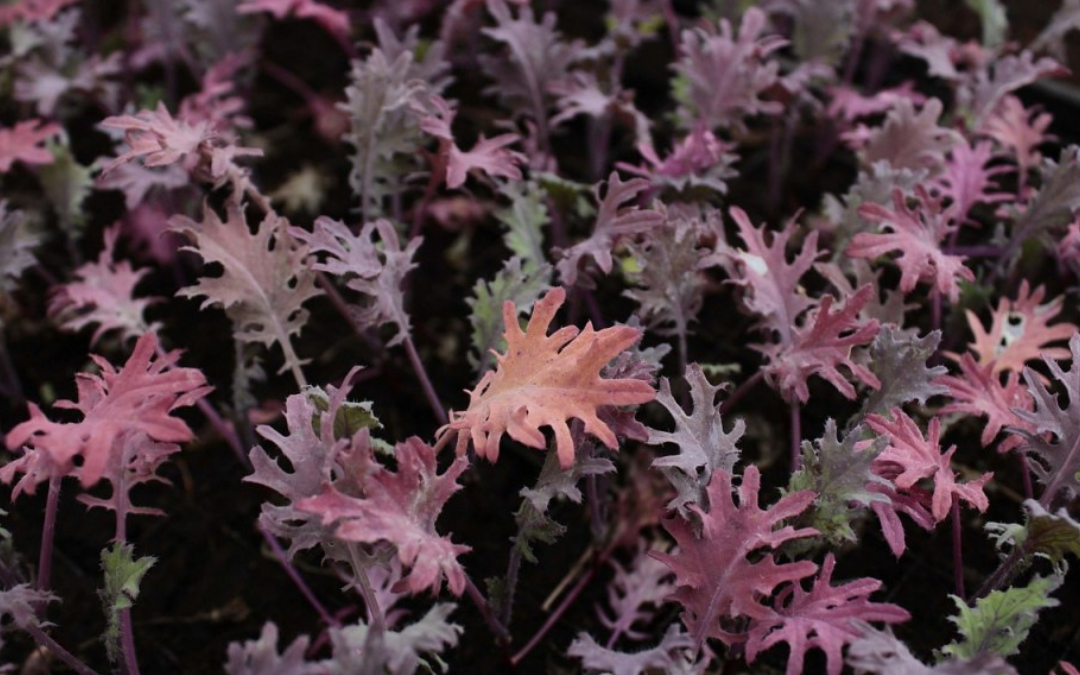Captivating Kale

Did you know that there are over 150 known cultivars of kale, with an array of colours, tastes and textures? Kale is easy to grow as long as it is protected from insect attack.
An ideal winter plant
Kale thrives in the cold, doing well in frosts and below zero temperatures. For Russian kale with its tinge of red, and red and purple varieties, the colder it is, the deeper the colour will be. The colder it is for most kales, the sweeter they taste.
Most popular varieties
Black Tuscan (also known as Cavalo Nero, Lacinato or Dinosaur), Russian Red, Red Bore (also spelt Redbor), Scarlet, Dwarf Blue Scotch, Halbhoher Gruner, Ivory Garden. All are available from the Diggers Club. There are also ornamental kales.
Position and season to plant
Choose a sunny, open position that is well drained and plant in autumn. Kale thrives in cold weather and the flavour is sweeter after frosts.
Soil
Dig over the soil to open and aerate it, but a fine tilth is not necessary. However removal of stones and roots is important as is breaking up large clods. Prepare by digging down to a spade’s depth. Add compost or well-aged manure.
pH
Kale prefers a pH of 6-7.5.
Sowing seed
Sow kale in punnets and plant out as seedlings. Prepare punnets by 3/4 filling them with seed-raising mix or potting mix and press this down firmly and water. Scatter the seeds onto this firmed bed. Add 6mm-1 cm of mix and firm, and water again (this stops the fine seed washing through and out the drainage holes). Keep moist at all times. Kale should be separated at the 4-leaf stage and planted out in seed trays – with 20 to a tray.
Plant out
Plant out when they are 5cm in height. Bury the roots and the lower leaves – it is fine to bury them, as it prevents plants wobbling in the wind. When plants are firmly in the ground they take up more water and nutrients, and therefore grow more leaves.
Spacing
Space seedlings 30-45cm apart.
Foliar feed
Spray with Seasol or Maxicrop fortnightly. These are seaweed preparations that provide the plants with essential trace elements that may be deficient in the soil.
Watering
Kale has moderate watering needs but do keep it well watered in summer.
Crop rotation
Rotate beds every year. Brassicas are particularly subject to various diseases so crop rotation is essential.
Pests and diseases
White cabbage butterfly: Kale is a member of the brassica family (cauliflower, cabbage, broccoli etc.) so the cabbage white butterfly loves it. They lay their eggs on the underside of the leaves and these emerge as very hungry green caterpillars and strip the kale leaves for food, killing the plant. There are 4 ways of dealing with caterpillars:
- Dip seedlings into Dipel (Yates Nature’s Way) which is an organic bacterium, toxic to caterpillars, just before planting (see video below).
- Plant American upland cress between plants. White cabbage butterfly will preference this plant when laying eggs. It is toxic to caterpillars.
- Net to exclude white cabbage butterflies. If you do not net, you will need to spray every 7 days with Dipel, covering both the upper and underside of all leaves.
- Remove caterpillars by hand when you see holes in the leaves – you may need a magnifying glass.
Snails and slugs: use bait.
Aphids: can be a problem in warm weather. Spray the underside of leaves with an organic bug spray such as Ecobug Insect and Mite Spray for Vegies, Fruit and Herbs.
Eating (or drinking)
Kale is regarded as a superfood because of its high nutritional content. Depending on the way kale is cooked it can be delicious or boring!
Tuscan kale is best for smoothies as it’s sweeter and blends more easily.
Russian Red and small curly varieties are best in salads.
Russian Red, Red Bore and Tuscan are the best cooking varieties.They are sweeter especially after frost and more tender.
Curly varieties can be tougher and are best in soups, finely chopped.
Kale chips can be made by chopping or tearing kale, spreading a single layer in a baking tray on baking paper, sprinkling with olive oil and salt, and baking for 5 minutes at 100°C. However, watch them closely, as variations in oven temperatures can cause burning.
Written by Robin Gale-Baker
